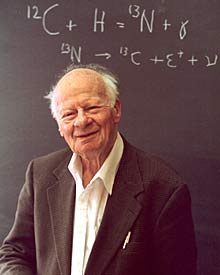
Hans Bethe earned the Nobel Prize for determining how stars generate energy. This research remains one of the greatest contributions to our understanding of the universe.
Courtesy Cornell University.
Hans Bethe, one of the towering figures of 20th-century astrophysics, died on Sunday, March 6th, at his home in Ithaca, New York, at the age of 98. Among his many awards and honors, Bethe (pronounced BAY-tuh) won the 1967 Nobel Prize in Physics for his theoretical calculations in the 1930s that demonstrated how stars generate energy — thus solving a mystery that had endured for centuries.
"His discoveries are honored on the highest possible level," says University of Illinois astronomer James B. Kaler. "He has the grandest award to be found anywhere: the Sun itself. He taught us how it works."
Bethe was born on July 2, 1906, in Strasbourg, which is now in France but was then part of Germany. He received his doctorate in physics from the University of Munich in 1928. After serving fellowships at Cambridge University in England and the Institute of Physics in Rome, he returned to Germany to serve on the faculty at the University of Tübingen. But being half Jewish, he was dismissed from his post after the Nazis seized power. He fled his native country in 1933, moving first to England, then in 1935 to Cornell University in Ithaca.
Bethe later said of his move to the United States, "I came to America expecting to be among strangers. I came home to Ithaca." Bethe spent the remainder of his academic career at Cornell.
Building upon earlier work by Arthur Eddington and Cecilia Payne, Bethe and Charles Critchfield made the detailed calculations in atomic theory that explain how the Sun and other stars generate energy by fusing hydrogen atoms into helium via a multi-step chain called the proton-proton process. Bethe also worked out the carbon cycle, the process by which massive stars generate their enormous luminosities by using carbon as a catalyst in hydrogen fusion reactions. He published his seminal paper "Energy Production in Stars" in 1938. This paper has withstood the test of time and remains a fundamental pillar of astrophysics.
Fearing the disastrous consequences of a Nazi atomic bomb, Bethe joined the Manhattan Project in 1943 and played an instrumental role in developing the bomb by leading the theoretical division at Los Alamos, New Mexico. But after World War II, Bethe was an outspoken advocate for international controls of nuclear weaponry and he helped persuade President John F. Kennedy to sign the Limited Test Ban Treaty in 1963.
In his later years at Cornell, he returned to astrophysics, devoting much effort to studying the mechanism of how massive stars explode as supernovae. Throughout the 1990s, Bethe's research continued to be published in leading scientific journals, and he wrote more than 300 scholarly papers during his career. Bethe was also known as an outstanding teacher, and he was beloved by generations of students, who fondly remember his muddy shoes and his preference for being called "Hans."
Bethe's passing ends humanity's last living link to the golden age of early 20th-century physics, when Niels Bohr, Werner Heisenberg, Erwin Schrodinger, Enrico Fermi, and other scientific pioneers worked out quantum mechanics and atomic theory.
Bethe is survived by his wife Rose of 65 years, a son Henry of Ithaca, a daughter Monica, who lives near Kyoto, Japan, and three grandchildren.
"The world has lost one of the great pioneers of 20th-century physics, and
Cornell has lost a beloved teacher, mentor, and friend," says Cornell president Jeffrey S. Lehman. "In the breadth of his insight, the rigor of his research, the depth of his social conscience, and the steadfastness of his commitment to Cornell, Hans Bethe set the standard for engaged scientific citizenship that will serve as a beacon for generations to come."
 0
0
Comments
You must be logged in to post a comment.